 I recently posted a a one shot Call of Cthulhu scenario based on the PC game Hotline Miami on RPPR Actual Play that confused some fans of the show so I thought I would try to explain what the hell I was going for when I ran Hotline Miami. If you haven’t listened to the episode yet, I suggest you do or this won’t make much sense. This post will have spoilers in it for Hotline Miami and Spec Ops: The Line.
I recently posted a a one shot Call of Cthulhu scenario based on the PC game Hotline Miami on RPPR Actual Play that confused some fans of the show so I thought I would try to explain what the hell I was going for when I ran Hotline Miami. If you haven’t listened to the episode yet, I suggest you do or this won’t make much sense. This post will have spoilers in it for Hotline Miami and Spec Ops: The Line.
The scenario contains 4 main elements: Hotline Miami the video game, the King in Yellow mythos, Spec Ops: The Line, and an idea I’ve had for a while – instead of making the player characters fight, let them share control of a golem that fights their battles for them. Keep reading to find out how I used them…
1. Hotline Miami
Watch this trailer:
Now, play the game and beat it or at least read this plot analysis from the excellent Fuck Yeah Hotline Miami Tumblr (many of the images in this post come from the Tumblr as well). Watch some gameplay footage too, while you’re at it. Get the idea? A game about a masked killer with a loose grip on reality, set in the heights of the Cocaine Wars of the 1980s in Miami, is perfect as the setting for a horror scenario. While the video game follows the action, horror role playing games usually work best as mysteries.
Hotline Miami is a mystery, but one without an answer. We don’t even know who survived the battle between Richard and the Biker at Phonehom for sure. First the player (controlling Richard aka the masked killer) kills the Biker in level 7. Later, the player controls the Biker and replays the same fight but kills Richard instead. Who won? Did the fight even happen? The Biker eventually confronts the people responsible for arranging the killings and either gets vague questions or hints about a ‘Russo-American Coalition’ that must be stopped. Apparently all the men in white suits that the player has been killing are Russian gangsters. That’s the most you’ll get out of the game itself. The game developers avoided giving the game a definitive backstory, allowing the players interpret the game for themselves. This is easy to do, because the cut scenes in the game are dreamlike and vague.
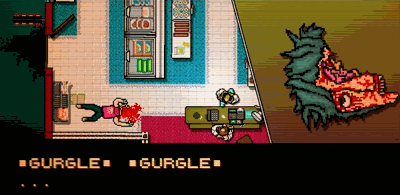 The hallucinatory dialogue scenes in Hotline Miami emphasize themes of madness and the difference between perception and reality. Several times in the game, Richard is confronted by several figures in masks asking him questions like “Do you like hurting other people?” and “Why are we having this conversation?” None of the questions are answered in the game and can really only be answered in the individual player’s mind. Later on, Richard hallucinates during the non-combat scenes, seeing mutilated corpses talk to him or vanish into thin air. At one point, a clerk even tells Richard “all of this is not really happening.”
The hallucinatory dialogue scenes in Hotline Miami emphasize themes of madness and the difference between perception and reality. Several times in the game, Richard is confronted by several figures in masks asking him questions like “Do you like hurting other people?” and “Why are we having this conversation?” None of the questions are answered in the game and can really only be answered in the individual player’s mind. Later on, Richard hallucinates during the non-combat scenes, seeing mutilated corpses talk to him or vanish into thin air. At one point, a clerk even tells Richard “all of this is not really happening.”
On a practical level, I took the puzzle piece mini game from Hotline Miami as a subquest in the scenario. In the video game, if you find all 15 letters scattered about the first 15 levels, you can unlock a secret ending in the Biker’s last epilogue mission. In my scenario, the player characters could have achieved the best possible ending (a return to reality and a realization of the truth) if they placed 3 letters so that Richard could find them. However, the players chose to enter the Castaigne mansion instead.
So while the game itself is a frenzy of action, the setting is perfect for a horror game. Many of the best horror RPG scenarios also focus on the terror of gradually losing a grip on reality, of falling into madness. In Call of Cthulhu, there is an subset of scenarios based on the mythos of the King in Yellow and Hastur that rely on similar themes.
2. The King in Yellow and Carcosa
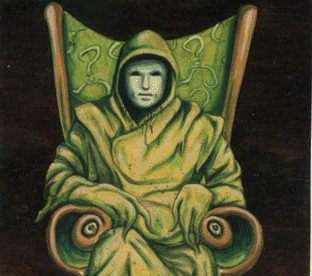 Originally a collection of horror stories by Robert W. Chambers, the King in Yellow has become an entire sub-genre inside the Cthulhu Mythos, in fiction and in games. I’ve been a huge fan of the King in Yellow since I read an essay on the Hastur Mythos written by John Tynes in Delta Green: Countdown. In it, Tynes lists several core themes important to Hastur based games: alienation, the surreal, creativity, and aesthetics. The essay also outlines a general campaign structure, in which these themes are gradually introduced and become more and more dominant until the player characters are confronted with Carcosa, the city of the King in Yellow. In the city, the player characters must find a way to escape or face eternity trapped inside the madness.
Originally a collection of horror stories by Robert W. Chambers, the King in Yellow has become an entire sub-genre inside the Cthulhu Mythos, in fiction and in games. I’ve been a huge fan of the King in Yellow since I read an essay on the Hastur Mythos written by John Tynes in Delta Green: Countdown. In it, Tynes lists several core themes important to Hastur based games: alienation, the surreal, creativity, and aesthetics. The essay also outlines a general campaign structure, in which these themes are gradually introduced and become more and more dominant until the player characters are confronted with Carcosa, the city of the King in Yellow. In the city, the player characters must find a way to escape or face eternity trapped inside the madness.
I’ve run a series of one shots in the last years where I’ve experimented with the sub-genre like The Night Shift, Night Clerk, and The Age of Masks. The Night games were inspired by Night Floors, a scenario written by Dennis Detwiller, originally published in Delta Green: Countdown and now available as a free PDF online. I keep returning to Hastur because I’ve never been fully satisfied with my own work. It’s a long term goal of mine to pull of a pitch-perfect Carcosa game, although lately I’ve been drifting away from pure Hastur mythos games and focusing more on architectural horror. The Construct, a game I ran twice, once at the tabletop and once online, and stripped Carcosa from the surreal horror. However, I don’t think I’ll ever entirely abandon Carcosa.
Hotline Miami has many similarities to a Hastur mythos game, although it’s not a perfect fit. The surreal elements build up throughout the game, culminating in a confrontation with a king of sorts, as Richard kills a Russian mob boss. The city of Miami definitely works as a model of Carcosa, given its anonymous houses filled with Russian gangsters in white suits, and equally strange stores and bars. Alienation is definitely a major theme in the game. Richard and the Biker are both loners and serial killers without a real friend. They have no past, no future, and no names. Creativity isn’t a major theme but players do get bonus points for flexibility – killing enemies with a variety of weapons gets more points.
Traditional King in Yellow stories typically draw their aesthetics from the original stories – namely Victorian or Edwardian decor and architecture. Hotline Miami chose a different historic era for its look, the 1980s instead of the 1920s. However, like The Repairer of Reputations, one of the original King In Yellow stories, Hotline Miami is set in an alternate universe. In Repairer, the narrator, Hildred Castaigne, believes himself to be heir to throne of the Imperial Dynasty of America. As the story progresses, the reader is left to wonder if anything the narrator says is true at all. As I played Hotline Miami, I thought back to Hildred and his narrative of murder and insanity. There are many stories with similar elements though so that was not enough to link Hotline Miami to Hastur. The masks did that.
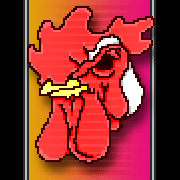 In Hotline Miami, masks are the most important characters of all. Richard is a nameless and weak character until he puts on an animal mask. Each mask gives him a unique power, from lethal punches to super speed. These masks consume his identity, allowing the player to more easily identify himself as the killer, and unlocking new masks is a strong motive to keep playing the game. Even the other protagonist, the Biker, is only shown briefly without his helmet. The janitors, who control the masked killer conspiracy, have a room filled with spare masks to hand out to new killers. Without masks, Hotline Miami would not be the game that it is. Fans of the game draw pictures or cosplay as the letter jacket wearing main character of the game. A man in a chicken mask is funny but a man in a chicken mask covered with blood is terrifying. Masks play an equally pivotal role in the King in Yellow. The most famous quote comes from an excerpt of the play, at a costume ball:
In Hotline Miami, masks are the most important characters of all. Richard is a nameless and weak character until he puts on an animal mask. Each mask gives him a unique power, from lethal punches to super speed. These masks consume his identity, allowing the player to more easily identify himself as the killer, and unlocking new masks is a strong motive to keep playing the game. Even the other protagonist, the Biker, is only shown briefly without his helmet. The janitors, who control the masked killer conspiracy, have a room filled with spare masks to hand out to new killers. Without masks, Hotline Miami would not be the game that it is. Fans of the game draw pictures or cosplay as the letter jacket wearing main character of the game. A man in a chicken mask is funny but a man in a chicken mask covered with blood is terrifying. Masks play an equally pivotal role in the King in Yellow. The most famous quote comes from an excerpt of the play, at a costume ball:
- Camilla: You, sir, should unmask.
- Stranger: Indeed?
- Cassilda: Indeed it’s time. We have all laid aside disguise but you.
- Stranger: I wear no mask.
- Camilla: (Terrified, aside to Cassilda.) No mask? No mask!
The King in Yellow is portrayed as a man with a mask, yet he does not wear one. We wear masks to conceal our identity, but the King in Yellow points out that we cannot hide from ourselves, that our disguised self is still the same as the real self. In between each level of Hotline Miami, the player is briefly shown Richard’s life in his apartment. After Richard saves a woman from a snuff porn studio, she lives with him for a while. The game shows that Richard seems to be normal between missions, at least for a while. Another masked killer, Richter, kills the woman and shoots Richard, leaving him for dead. When he eventually returns to his apartment, it has been ruined, his car vandalized. Wearing the masks did not protect him. They only enabled him to kill freely.
So after I started playing Hotline Miami, I could not get the idea of mashing it up with the King in Yellow out of my head. The obvious scenario would be to make the players masked killers Like Richard, Biker, and Richter but that had significant problems. In Hotline Miami, players can instantly restart if they die. Tabletop games don’t work like that and a combat-heavy game has to allow for players losing fights as well as winning them. Otherwise combat is meaningless. Normally, players can flee if they lose a fight or roll up a new character. Neither of those solutions would work for a tabletop Hotline Miami/Hastur based game. There’s also the fact that each masked killer works alone, not as a team. These issues put me off from doing a masked killer game. Instead, I went to the mysterious janitors that seem to be pulling all the strings. That let me use the third element, the golem myth.
3. The Golem
For a long time, I’ve thought creating a game where the player characters don’t fight their own battles but control or guide an immensely powerful being, like the golem of Jewish myth. Instead of games where the challenge is to defeat a foe through heroics, clever tactics, and teamwork, I wanted a game that focused on the moral and ethical issues of violence and the practical challenges of keeping such a dangerous being under control. The golem could defeat practically anything the players chose to send it against, but there’s always the chance for collateral damage, losing control of it, or sending it against the wrong target.
So for this one shot, I wanted to give the players control of the masked killers and see what they did. I realize now that they didn’t pick up on this fact quickly enough.
4. Spec Ops: The Line
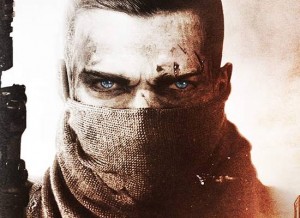 I pulled one idea from this game: that the player characters were the real bad guys all along without realizing it. Captain Walker and his team committed numerous atrocities in order to chase a phantom villain and validate their identities as heroes. This gave me an idea – what if the player characters were the cultists behind the evil in the first place, but didn’t realize it? This required amnesia, which I admit is a cliche in horror games, but I felt it would work here.
I pulled one idea from this game: that the player characters were the real bad guys all along without realizing it. Captain Walker and his team committed numerous atrocities in order to chase a phantom villain and validate their identities as heroes. This gave me an idea – what if the player characters were the cultists behind the evil in the first place, but didn’t realize it? This required amnesia, which I admit is a cliche in horror games, but I felt it would work here.
Throughout the game, I tried to provide hints about the characters’ identities as cultists of Hastur – I halved their starting sanity at first. They also found a notebook in their handwriting giving instructions on what to do. Later on, after the players realized that they had sent Richard to kill I asked them if the murders cost them sanity instead of just making them roll. This was really my way of asking them if their characters were comfortable as cultists or not.
Putting it all together
With all of these elements, I outlined a scenario. It was a mystery where the player characters had to investigate themselves. My goal was to make the central dilemma whether the characters would accept their nature as cultists or if they would reject it and try to return to reality. The trick was to not label each choice directly, but not keep the choices so mysterious that the players could not interpret them at all. But to find the two choices, they had to do some legwork first. I gave them a few starting clues – namely a notebook written in Tom’s character’s handwriting, an address to a safehouse and a note with instructions to call a particular phone number and leave a specific message on the answering machine. As they read through the notebook and made the call, I gave them all some sanity back, without explaining why. Since they were cultists, I decided that any action they did to further the cult’s goals would make them feel better, at least until they realized the truth. They read the notebook and went to the safehouse and found more leads to investigate. Eventually they figured out what the answering machine messages were about and received some clues about a mysterious Castaigne family with ties to Russian gangsters.
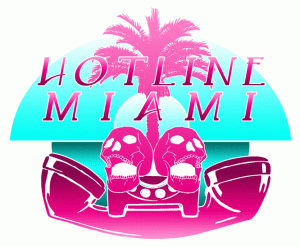 They eventually learned they had two main choices: place 3 puzzle pieces at sites where Richard would find them or find the Castaigne estate. In the playtest, Tom did not make sanity checks for Richard’s murders, so I told him that he thought the mansion was a better idea. Aaron and Drew made sanity checks so I suggested that the puzzle pieces were more important. This was the key clue but I didn’t want to oversell it so they could freely make their choice.Tom and Aaron chose the estate while Drew refused to make a choice.
They eventually learned they had two main choices: place 3 puzzle pieces at sites where Richard would find them or find the Castaigne estate. In the playtest, Tom did not make sanity checks for Richard’s murders, so I told him that he thought the mansion was a better idea. Aaron and Drew made sanity checks so I suggested that the puzzle pieces were more important. This was the key clue but I didn’t want to oversell it so they could freely make their choice.Tom and Aaron chose the estate while Drew refused to make a choice.
Since Tom and Aaron chose the Castaigne estate, they had no choice but to send Richard to clear the path first. Once inside, they learned the truth. Tom put on a mask. Aaron shot and killed Tom but before Aaron could leave, he had to get past the King in Yellow. He failed his sanity check and was pulled into Carcosa. Meanwhile, Drew was left in purgatory, unable to resolve the mystery one way or the other.
Final thoughts
The thematic links between Hotline Miami and the King in Yellow are too good to leave alone. I’ll probably revisit this idea again but next time, I’ll spend more time writing up the investigation so the players have more of a chance to figure out the mystery and make informed choices. I definitely need to address why the King in Yellow chose 1989 Miami to manifest or why the cult is active in that era. I’ll also probably want to throw in some connections to Miami Connection because that movie is insane.
My biggest problem with my Carcosa games are my endings and overall structure – it’s fine to be cryptic and weird in the beginning but a bad ending diminishes the quality of the entire story. I think the endings of Hotline Miami work perfectly fine as they are but tabletop role playing games are different from video games and I don’t think I’ve hit the right emotional tenor in my Carcosa games that Hotline Miami did with its endings. It’s a worthy goal to strive for so perhaps I’ll achieve it before the costume ball reaches midnight and we all unmask.
4 replies on “Post Mortem of Call of Cthulhu: Hotline Miami”
[…] read more about this scenario on my blog! […]
[…] Post Mortem of Call of Cthulhu: Hotline Miami » Slang Design | Slang Design on RPPR Actual Play: Mutants and Masterminds – The Age of Masks 1 […]
I effing LOVED listening to this game. It was interesting to see you break down your choices and decisions as to what to put into the game and why. Keep it up.
Would it be possible to get a copy of the GM notes for this session?